
23 minute read
WHO IS PANAMA JONES • Winston Rice has always enjoyed taking on big projects . 20
By Reed Boettcher Panama Jones
& The Town Of Clarita
Nestled in the farmland of Coal County is the quiet town of Clarita. For many, the town is known for hosting the Amish School auction every September, but for Winston Rice it’s known as home. It’s said home is where the heart is. This must be true, for Rice has spent the last couple of decades pouring his heart and soul into restoring his hometown. Some might see Clarita as the town time forgot. After all, it isn’t uncommon to see a horse drawn carriage when passing through the area. As for Rice, he sees Clarita as a town rich in culture with the capacity of sustaining independent businesses. Winston Rice is a nostalgic visionary who isn’t afraid of tackling big projects. Looking for adventure, Rice followed in his father’s footsteps and joined the military. While in the Army, Rice went to Jump School and Parachute Rigger School where he became a Paratrooper. After being stationed in France and Germany he re-enlisted and was assigned to an airborne unit in Panama. Rice served three tours of duty in Panama as a Paratrooper. In his off time he sought out adventures such as: scuba diving, trekking across the isthmus, fishing, searching for artifacts, and exploring the many nooks and crannies of Panama. During such explorations is where he first met the Embera Indians of the Darien Region. His intrigue with the culture and love of the climate would later result in his establishment of an adventure tourism company in Panama. December 22, 1972 Rice set a world record parachute jump. He and eight others performed nine way jump formations on the Panama Atlantic and Pacific coasts within two hours. At the age of 23, Rice earned a Master FAA Parachute Rigger license making him the youngest person to
achieve this rating at the time. With over 600 jumps to his resume, Rice finally known for hosting the Amish School auction ended his military career as an Army newspaper editor ended his military career as an Army newspaper editor at Fort Richardson near Anchorage, Alaska. While in Alaska he learned the trade of cabinet making and met his wife, Linda. The cold climate couldn’t have been more of an opposite to the warmths of Panama. After several winters and a severe case of cabin fever Rice and his family moved to his hometown of Clarita where they set up shop and started developing their Panama tourism business. At first their tourism business started off slow so Rice sought further education in tourism and computer technology to enhance their business. During this time Rice became aware of the importance of the internet medium. Even though the world wide web was in its infancy, Rice and his family developed and bought www.panamacanal.com which impacted their business tremendously. Imagine the frustrations this caused the Panama tourism development officials. The newly marketed website generated so much business that it became necessary to establish an office in Panama to receive their tourists. Rice and a few of his long time friends worked together to develop a tourism program that encompassed historic Panama locations as well as native inhabited rainforests. Rice began working with the Embera Indians on the Chagres River where he was at the forefront of incorporating the natives into Panama tours. His long standing relationship with the local Indians brought prosperity to the tribes and a authentic touch to the tours. After several attempts to register the company’s name Rice and others eventually decided to name the

Opposite Page: Rice stands in front of the renovated Church of Christ building now built to look like an old school house. The building is a future site for retreats, workshops, seminars and even weddings. Right: Rice takes time to pet his loyal companion in front of Schmelzer’s which is home to Velma’s Kitchen. Dinner is served here every Friday night, by reservations only. Schmelzer’s was the local Blacksmith Shop and Garage in the 30’s. Photos By: Reed Boettcher

business after his nickname. In 1997 Panama Jones was official and running on autopilot. This allowed Rice to begin his ongoing labor of love to restore and develop the town of Clarita. For Rice the development and marketing of a town that has no draw for consumers is based on the area’s cultural and historical richness. Rice’s love of antiquities and preservation of the past has played a key role in the developing of the current vendors and services offered at Clarita. His vision of a “Mayberry like” community, where retail business offer unique products in a family friendly setting, is different than commercialized tourist traps such as Branson, Missouri. Rice commented on his overall vision and concepts for his beloved home town. “In a lot of ways the development of Clarita has been harder to get started than the Panama touring business. The first step was a labor intensive clean up of the properties I was purchasing. Then, for it to really work I was going to need community involvement. It’s one thing to restore and market a building in a way that attracts people to the area and it’s another to convey my concepts where people will understand and want to be involved. In many aspects getting others involved is my main objective. Getting the locals involved and excited about the possibilities of creating independent money is key to these project’s success. My biggest supporters in developing Clarita economically have been members of the local Amish community.” Rice has restored and rebuilt several structures in the town which were the stepping stones for obtaining is overall goal. Rice purchased the “Moore House” in 2005 which he restored and furnished to its original design. Built in 1909 by the town’s barber, this historic home is now available for guests to enjoy for $75 a night. Three years of restoration is evidenced in Rice’s attention to details. Another current and completed project is Schmelzer’s, home to Velma’s Kitchen offering all you can eat country style dinners every Friday night, by reservation only. Velma’s Kitchen also caters private parties at Schmelzer’s and other locations. Schmelzer’s has also been host to many special events including fund raisers, family reunions, weddings, civic group meetings,

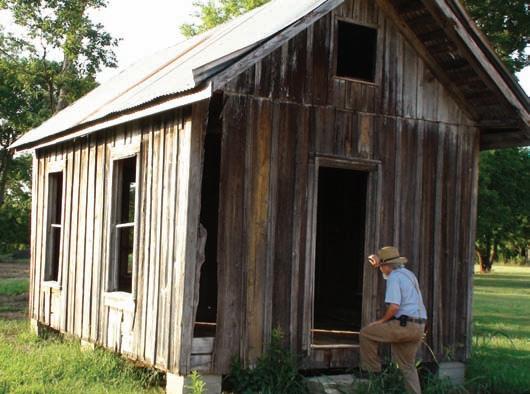
Above Top: The Moore house was built in 1909 by the towns barber, Cecil Kitchens. In 1923 the house was purchased by John and Opal Moore. Win and Linda Rice purchased the property in 2005 and began a three-year labor of love restoring the house. This historic house is now available for guests to enjoy. Above Bottom: General Mule” Waveren was a scout for General Custer. He lived and died in the small cabin near Clarita. Recently Rice acquired the cabin and moved it to town for restoration as a monument to Waveren. He was not a General only a scout. General was his first name. Photos By: Reed Boettcher




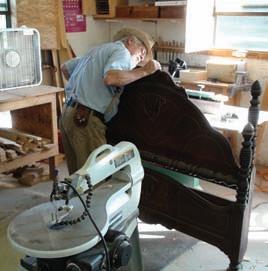

Above: Rice shows some custom trim work he has done for his restoration projects. He also restores period furniture such as the headboard above. Photo By: Reed Boettcher Above: Winston uses his Kubota B7800 lawn tractor on every job at Clarita. His Kubota has been a crucial tool in many of his restoration projects, especially in the exterior landscaping of the buildings. He comments on how useful it is, and that he would be lost without it. Photos By: Reed Boettcher

and church organization meetings. Another business that was started at Schmelzer’s is Got Grub. Operated by Ronda Sharp, she prepares lunches for delivery throughout Coal County. Currently, Saturday night dinners are in the works for two entrepreneurs that will alternate BB-Q and catfish dinners. “Schmelzer’s has a lot of potential so I have never wanted to be tied down to making it strictly a restaurant. Right now it serves as an incubator to those looking to break out in the restaurant business. Offering people of this community a chance to provide their services not only makes me happy, but plays a key role in getting others involved,” says Rice. Other ongoing projects include the restoration and remodeling of Clarita’s Church of Christ building. This large building has been restored to look like a period school house where retreats, workshops, seminars and even weddings can take place. The school house is built using quality craftsmanship and an antique touch while still offering all the modern day technologies to accommodate large business meetings. Rice recently acquired another piece of Clarita history, an old cabin owned by General “Mule” Waveren who was a scout for General Custer. Fortunately Waveren wasn’t present the day of the “Little Bighorn Massacre”. Unfortunately he did lose his arm shortly after in another small battle. The cabin where Waveren lived was relocated by a team of mules from the nearby woods to Clarita’s main street where it will be restored for public display. For Winston Rice, taking on big projects is just away of life. Whether he’s breaking sky diving records, or spending hours landscaping on his Kubota, he knows that some things start with a leap of faith. To find out more information about Clarita or Panama Canal tours email Winston Rice at claritaok@ gmail.com or info@panamacanal.com. GREAT PLAINS LIVING 22 www.greatplainsliving.com


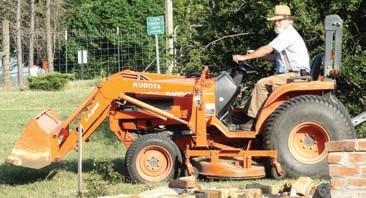


www.greatplainskubota.com
ADA 1212 N. Broadway 855-4KUBOTA DUNCAN

3445 N. Hwy. 81
A Mid Summer Meal

Roast Beef On The Grill


Fire Up The Grill For An Alternative Cooking Method to this Classic Cut
Recipes



1 Eye of Round Roast Large Bottle of Wishbone Italian Dressing 1 Stick of Butter 1. Marinate eye of round roast in Italian Dressing overnight 2. Prepare the grill for a low and slow cook 3. Sear the roast on all sides to lock in juices 4. Cook closed yet vented for 45 min 5. Take roast off and rub with butter cover and let rest for five to ten min (Should Turn Out Medium)






Squash Casserole
















From The Boettcher Garden, A Great Recipe For Excess Produce
2 Cups of Cooked Squash 2 Eggs, Beaten 2 Oz. Jar Pimentos 1 Cup Shredded Cheddar Cheese 2 T Sugar 1/4 Cup Butter, Melted 1/2 Cup Milk 1 Cup Cracker Crumbs 1/4 t salt 1. To cook squash steam or boil in water on stove top 2. Beat 2 eggs thoroughly 3. Drain Pimentos 4. Shred Cheddar cheese 5. Melt butter 6. Crumble up saltine crackers 7. Carefully combine in a large greased Casserole dish 8. Bake at 300 degrees for 30 minutes
Orange Stuff
A light and fluffy way to enjoy and incorporate fruit and dairy to a meal

12 Oz. Large Curd Cottage Cheese 1 Can Crushed or Chunk Pineapple, Drained Chunk Pineapple, Drained 1 Can Mandarin Orange Sections 1 Large Carton of Cool Whip 1 Large Carton of Cool Whip 1 Small Box of Orange Jello 1. Mix Cottage Cheese, Fruit and Cool Whip 2. Sprinkle Dry Jello and blend well 3. Chill in Refrigerator Overnight or at least a good five hours




Share the joy of your family’s kitchen with Great Plains Living! Submit your recipes by email or mail to: rboettcher@greatplainskubota.com or P.O. Box 876 Ada, OK 74821


Great Plains
1212 N. Broadway Ada / 3445 N. Hwy. 81 Duncan 855-4KUBOTA / www.greatplainskubota.com






By Reed Boettcher From Fitzhugh to Kotzebue





How do you span the countless miles from Fitzhugh, Oklahoma to Kotzebue, Alaska? The preferred method is flying for but some members of the Fitzhugh Baptist Church it’s a walk of faith. Great Plains Living got a chance to interview Daniel Wilburn, Sunday School Director at Fitzhugh Baptist Church about his involvement with the Freedom Camp, which is held for native youths from villages near Kotzebue, Alaska. Through the mission efforts of Fitzhugh Baptist Church, Wilburn unselfishly gives his time by doing anything from leading small group Bible studies to cleaning portable toilets at this primitive camp. Wilburn gave Great Plains Living insight to the much needed missionary work that took place in the Arctic Circle this July. Q: How did the Freedom Camp get started? A: It started four years ago with Zane and Kandy Newton along with Lance Kramer, a missionary from Kotzebue Alaska at Super Summer Oklahoma. Super Summer is a training opportunity for youth ministers to bring Christian people together who are interested in advancing their personal spiritual growth. We got involved because they were commenting on their need for a cook for this camp near Kotzebue. My father, Steve Wilburn who’s the Pastor at Fitzhugh Baptist, commented that he had experience cooking for youth at Falls Creek. Q: Why Kotzebue? A: Kotzebue is Kramer’s hometown. There’s also a real need for missionary work there due to the high suicide rates among young people. In fact the rates are well over the national average in these remotely rural towns with over half of the suicides being committed by native kids and teenagers. Q: What was the overall mission? A: Reaching out to the kids was the main objective. There seems to be no hope among the young people. Society roles have changed because their way of life has been altered by westernization. These people have survived by the males of the family providing their needs in an extremely harsh environment. With outsiders of the western world basic needs became cash. This created a big shift in what was essential to survive. It seems the people who have adapted to this the most are the women. As a result women are becoming heads of the households. Altogether it has created a depressed and altered culture which results in high amounts of alcoholism and other negative behaviors. What we want to do is reach out to the kids of these tiny communities and let them know there is hope. Q: How was the camp able to achieve this? A: We wanted the young people of the communities to understand that you can find refuge and solace

through the love of Christ. Q: Did you make any personal connections with members of the camp? A: Yes, I was in charge of a small group of about six guys and there was this one kid that really opened up to me, and shared the hardships he has endured growing up. Despite what he has been through he always has a positive outlook, and he always wears a smile. Over the three trips I’ve taken there I have seen change in him. He wasn’t always positive but you can tell he has hope now. We are good friends and we stay in touch. His outlook on life lets me know things are working well, and the messages we preach are reaching our kids. Q: What are some of the camp activities? A: We have worship and chapel times during the day. We also hike. We are 45 miles away from any civilization and we have a two-hour boat ride to get to our camp so everything we do keeps us busy. We also have archery. Most of all we just hang out, which some of these kids don’t get to do regularly. It’s a place where they can relax and let their guards down long enough to just hang out with no worries. Q: Were there any places to eat besides the food you cooked at camp? A: There were little stores where you could get hamburgers for about $14. Q: What were some of the highlights for you? A: Seeing kids leave with hope when they felt there was none. They can go home and be the change that could positively impact their generation. Q: How long did you stay? A: We stayed ten days. The Fitzhugh Baptist Church gave us great support. They packed flat rate boxes full of food and mailed them to Kotzebue where they were sent by boat to the isolated camp. Q: What cultural challenges were you faced with? A: At first it was hard just getting them to talk. They are really quiet people. They often communicate through facial expressions, not words. While eating spaghetti during one particular trip, I asked a kid if he liked his food. He gave no response and I finally realized by his expression he was saying yes. Over the years I feel we’ve gotten over those boundaries because they have really opened up to us. Q: What were some of the difficulties you had? A: A major issue was trying to get the kids to go to sleep. During the summer they stay up until four or five in the morning because it basically stays light all night. The first year we tried to make breakfast at nine. That didn’t work because we could not wake them up. So this year we cooked breakfast at eleven. I noticed kids walking around town at three or four in the morning. You see that in Ada and you think the kids are up to no good, but in Kotzebue I think they are just trying get away or find some sort of peace on the streets. Q: Do they integrate their native culture in their worship? A: The natives have a long Christian background, but it has gone down hill over the years. Their culture is a part of everything they do. I did notice they sing hymns in their native language of Iñupiaq. Q: What would you like to see come from this camp in the future? A: We would like to see a camp that does not need us, and we are seeing this as a reality. We have
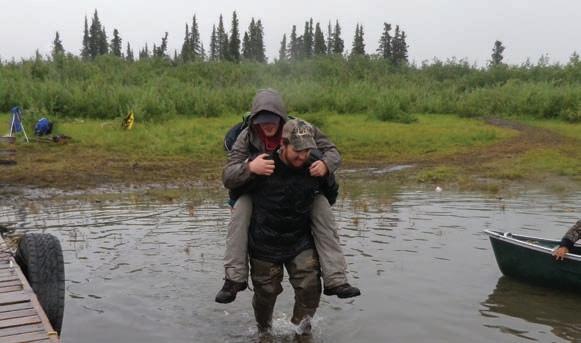
Above: Don’t Get wet! Daniel Wilburn gives Chandler Smith a piggy back ride through the water. Previous Page: Pictured in the tent are Katie Johnson, Daniel Wilburn, Sean Corser and Jessica Penner. Posing on the beach is Daniel Wilburn, Jessica Penner, Chuck Lotter, and Carter Smith, Chandler Smith and Dana Smith. Photos Submitted By: Danna Smith had several kids that have come back year after year, and we notice positive changes every time. Q: How has all this impacted your life? A: It makes me grateful for what we have here, and it has given me a whole new perspective on life. I really appreciate things I have. To see that some of the kids have accepted Christ as their savior and to see the change in their lives over the years really lifts my soul. Q: As Sunday School Director how do you get others involved? A: It all starts with sharing. I share the stories and what I’ve seen. It seems to get people interested and more involved with what we are doing. Q: If you could do the trip over today, what would you do different? A: When I was there I didn’t hold anything back. I didn’t want any what if issues coming up. After all its not like you can hop in the car and go back. The teachings of Christ, which guide Wilburn through his life are the foundations of providing hope for those who desperately need it. His work at the camp proves that Christ’s love transcends cultural differences and can make change in the harshest conditions and smallest of communities. GREAT PLAINS LIVING 29
batwing®

WOODSBATWINGS • Exclusive “quick-change” blade system WOODSBATWINGSWOODSBATWINGS Dealer Imprint Area allows for easy changing of blades • Deep side frame and sloped deck has greater material capacity for • Exclusive “quick-change” blade system allows for easy changing of blades• Exclusive “quick-change” blade system allows for easy changing of blades efficient, productive cutting• Deep side frame and sloped deck has greater material capacity for efficient, productive cutting Dealer Imprint Area• Deep side frame and sloped deck has greater material capacity for efficient, productive cutting Dealer Imprint Area

woodsequipment.com Great Plains Kubota “Ride With The Brand”woodsequipment.com ADA • DUNCAN 855-4KUBOTAwoodsequipment.com
www.greatplainskubota.com




SVL OVERVIEW SVL OVERVIEW
PRODUCTIVITY DURABILITY VERSATILITY
By Reed Boettcher By Jamie Anderson

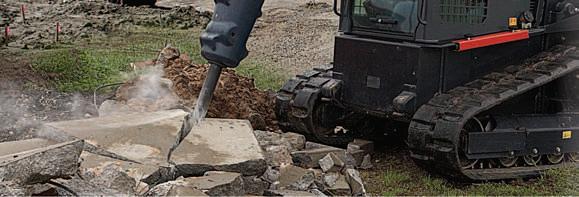

1. Check track tension often & keep debris free 2. Keep em’ clean inside & out 3. Check air filter often in harsh conditions 4. Check hydraulic fluid often 5. Always check engine oil on a regular basis 6. Know and use the maintenance schedule 7. Keep pivot points lubricated 8. Check coolant level often 9. Inspect for leaking cylinders periodically 10. Maximize A/C efficiency by blowing out condenser and radiator. Make sure fan belt is tight and in good condition & keep cab clean.




Kubota’s SVL75 and SVL90 compact track loaders were designed to handle a wide range of tasks while keeping operator comfort in mind. The exceptionally comfortable cab features a wide entrance for easy mounting and dismounting along with plenty of leg room to reduce operator fatigue. Models equipped with a pressurized cab offer protection from the elements and an excellent air conditioning system. The easy open, sliding front window allows the operator to get in or out of the loader regardless of attachment position by sliding up and into the cab. The wide variety of attachments available for use on the SVL series make it a versatile, multi-tasking machine. Their best in class four cylinder, turbo charged engines provide great fuel economy and unmatched performance. Also, the vertical lift design and low center of gravity deliver exceptional stability while loading materials and leveling surfaces. SVL uses include: brush hogging, post hole and ditch digging, sweeping, breaking and grappling rock, tree shearing, material handling and even seeding. Mostly used in construction, the SVL is ideal for farming and agricultural functions. Garrett Clark, Store Manager at Great Plains, comments on the SVL90 usage at his family’s farm. “We use it for as many jobs as we can, but mostly for moving dirt and hay and lots of tree removal. It is amazing how fast you can get a job done. I can do three months worth of work in three days. It really saves us time.” Serviceability on hard worked machines should always be a consideration when comparing models. The SVL makes maintenance and inspections faster and safer with a tilt up cab capable of reaching a 72 degree angle. Here hydraulic pumps, valves, lines and the hydraulic tank can be reached. Daily or routine checks can be performed by opening the bonnet. The slide and tilt radiator also enhance easy maintenance. A key factor to the durability of this series is its outstanding crawler performance. Using the technology of their mini excavators Kubota has proven their track systems give longlife and high performance. The undercarriage forms an integral part of the main frame for maximum durability. These factors combined show the impressive strength of the Kubota SVL series. The Kubota SVL series provides high levels of productivity giving operators hours of comfort and the ability to handle dynamic applications with a variety of attachments. The serviceability and longevity of these machines make them desirable in the construction market as well as the agricultural markets. CHECK THE SPECS
Bucket Breakout Force:
Arm Breakout Force:
Lifting Capacity:
Tipping Load: 6204 lbs 4766 lbs 4881 lbs 6570 lbs
Above: Kubota SVL’s are frequently used in dairy operations. The maneuverability and size make certain mowing applications easier to complete. Photo Available By: Kubota Tractor Corporation SVL75 SVL90 7961 lbs 6742 lbs 5869 lbs 8600 lbs









